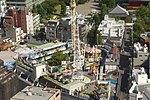Hōzōmon
AsakusaGates in Japan

The Hōzōmon (宝蔵門, "Treasure-House Gate") is the inner of two large entrance gates that ultimately leads to the Sensō-ji (the outer being the Kaminarimon) in Asakusa, Tokyo. A two-story gate (nijūmon), the Hōzōmon's second story houses many of the Sensō-ji's treasures. The first story houses two statues, three lanterns and two large sandals. It stands 22.7 metres (74 ft) tall, 21 metres (69 ft) wide, and 8 metres (26 ft) deep.
Excerpt from the Wikipedia article Hōzōmon (License: CC BY-SA 3.0, Authors, Images).Hōzōmon
Nakamise-dōri, Taito Asakusa
Geographical coordinates (GPS) Address External links Nearby Places Show on map
Geographical coordinates (GPS)
| Latitude | Longitude |
|---|---|
| N 35.713961111111 ° | E 139.79666666667 ° |
Address
宝蔵門
Nakamise-dōri
111-0032 Taito, Asakusa
Japan
Open on Google Maps










